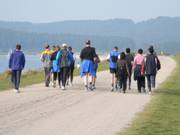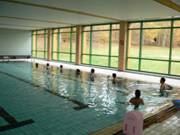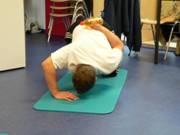Fitness
Introductory remarks
At a time when workers are expensive and many companies have to lay off employees, the productivity of the individual has come to the fore. Every company therefore wants healthy and resilient employees. But what can a company do to improve the health, resilience, stress management and well-being of its employees? Well, there may be several possibilities and perspectives, but it is clear that regular physical activity can make an important and comprehensive contribution.
As early as 1994, the U.S. Department of Health published a report on the positive effects of sport on health. Sport has many health benefits: The best known are the preventive effects on the cardiovascular system and the muscles, but also the metabolism and the immune system (American Centers of Disease Control, 1996). Other effects observed by the American Centers of Disease Control (1996) include lower mortality rates, fewer heart attacks and a reduction in other cardiovascular diseases, lower blood pressure and lower body fat levels. In addition, regular athletes have a lower risk of developing diabetes mellitus, osteoporosis and depression and can more easily avoid falls in old age.
In a statistic of the Federal Statistical Office of Germany (2005) on the ten most frequent causes of death in 2004, heart diseases occupy the first three places, accounting for almost 24% of deaths. Nuremberg in particular is the stronghold of heart attacks within Germany, so action is particularly necessary here. In addition, there are strokes, lung diseases and diabetes mellitus, all diseases with risk factors that can be demonstrably compensated for physical activity (Anderson et al., 2005).
According to Brehm (2002), the goals in health sports should be to reduce risk factors, complaints and discomfort, to strengthen health resources and to develop a healthy lifestyle in terms of sustainability.
Goals and contents
The Lifestyle – Company Fitness programme aims to motivate the employees of companies to adopt a more active lifestyle. To this end, the participants were introduced to and practised various sports. The aim was to give the participants a broad insight into various sports so that they could discover a sport that was suitable for them. The aim for those who were already active was to improve and intensify their sporting activities and get to know new sports variations. The goal for inactive people was to experience the technique and fun of different sports and discover them for themselves.
The following sample lesson contents were proposed in a rough version by the intervention leaders. The participants then had the opportunity to contribute their own wishes and suggestions. For example, the golf and Capoeira suggestions were included in the timetable and implemented.
In the end, there were eight hourly sessions, which are briefly presented in the following. Most of the sessions ended with relaxation in order to promote physical and psychological relaxation and to show the participants possibilities for stress reduction in everyday life.
Example of a Lifestyle – Company Fitness Programme
Unit 1: Walking and preliminary test
 In the first unit at the Water Sports Centre, the focus was on getting to know the participants. Afterwards the participants were introduced to the technique of walking. The final part of this training session was the preliminary test, which is described in more detail under point 3.
In the first unit at the Water Sports Centre, the focus was on getting to know the participants. Afterwards the participants were introduced to the technique of walking. The final part of this training session was the preliminary test, which is described in more detail under point 3.
Unit 2: Sailing
 The second unit consisted of a trial sailing lesson conducted by the instructors. The boats and other equipment were borrowed from the Water Sports Centre of the University of Erlangen-Nuremberg. Due to the time-consuming content of this unit, no further lessons were held.
The second unit consisted of a trial sailing lesson conducted by the instructors. The boats and other equipment were borrowed from the Water Sports Centre of the University of Erlangen-Nuremberg. Due to the time-consuming content of this unit, no further lessons were held.
Unit 3: Golf

The third unit took place at Zollmühle Golf Club. In addition to teeing technique, the techniques of putting and chipping were learned on the driving range and the putting green. The clubs were borrowed from the golf club.
Unit 4: Jogging and water aerobics
 In the fourth unit, the technique of jogging was practiced in more detail, observed and corrected. This unit was conducted outdoors on a 45-minute route along Great Brombach Lake.
In the fourth unit, the technique of jogging was practiced in more detail, observed and corrected. This unit was conducted outdoors on a 45-minute route along Great Brombach Lake.
 The second part of the session took place in the indoor swimming pool in Pleinfeld, where the trainers held one hour of water aerobics per group. The indoor swimming pool was reserved for the groups at that time.
The second part of the session took place in the indoor swimming pool in Pleinfeld, where the trainers held one hour of water aerobics per group. The indoor swimming pool was reserved for the groups at that time.
Unit 5: Strength training with everyday equipment
 In the fifth unit, strength training with everyday equipment was presented and carried out. Plastic bottles of 0.5 litres and 1.5 litres were used as everyday aids. Exercises with Therabands were also performed. The strength training was mainly designed for the back, abdominal and arm muscles.
In the fifth unit, strength training with everyday equipment was presented and carried out. Plastic bottles of 0.5 litres and 1.5 litres were used as everyday aids. Exercises with Therabands were also performed. The strength training was mainly designed for the back, abdominal and arm muscles.
Unit 6: Nordic walking
In this course unit the trend sport Nordic walking was introduced. A qualified Nordic walking trainer was present. The path along Lake Brombach was chosen as the training area. Besides technique, strengthening exercises as well as stretching exercises were carried out.
Unit 7: Capoeira
In the penultimate session, an experienced Capoeira fighter was invited to introduce the participants to this sport. The participants were given an insight into the Capoiera fighting and dancing sport and learned their first movements. Strength, agility and coordination were trained.
Unit 8: Back-friendly behaviour and final test

In the last unit, the battery of tests from the first hour was repeated to measure changes compared to the preliminary test. In the remaining time, the participants were given advice and suggestions for back-friendly behaviour in everyday life. In addition to the correct sitting position, the participants were also advised on how to lift and carry correctly and did some exercises resembling everyday life movements.
Offerings
Let us make you an appropriate offer!
Contact
Prof. Dr. Heiko Ziemainz
Department of Sport Science and Sport
Geschäftsbereich Lehre Sportwissenschaft
- Phone number: +49 9131 85-25464
- Email: heiko.ziemainz@fau.de